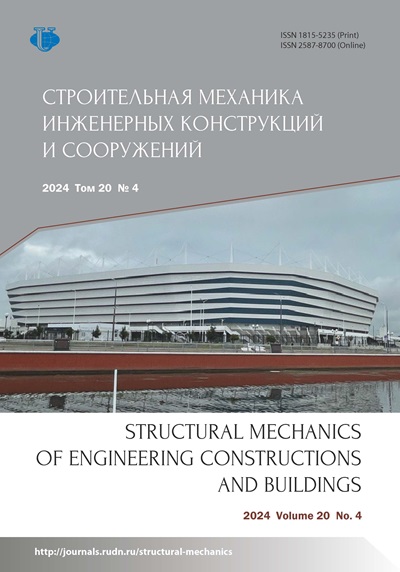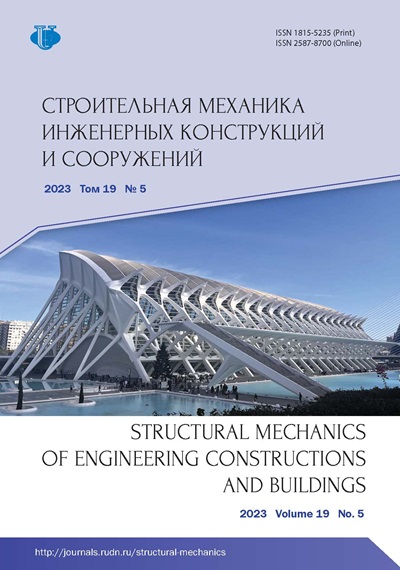Generation a solution to the equations of elasticity theory for a layered strip basing on the principle of compressed mappings
- Authors: Zveryaev E.M.1, Rynkovskaya M.I.1, Hoa V.D.2
-
Affiliations:
- RUDN University
- Moscow Aviation Institute (National Research University)
- Issue: Vol 19, No 5 (2023)
- Pages: 421-449
- Section: Analysis and design of building structures
- URL: https://journals.rudn.ru/structural-mechanics/article/view/37217
- DOI: https://doi.org/10.22363/1815-5235-2023-19-5-421-449
- EDN: https://elibrary.ru/FKHYLG
Cite item
Full Text
Abstract
A systematic presentation of the modified classical semi-inverse SaintVenant method as an iterative one is given on the example of generating a solution to the differential equations of elasticity theory for a long layered strip. The firstorder differential equations of the plane problem are reduced to the dimensionless form and replaced by integral equations with respect to the transverse coordinate, just as it is done in the Picard method of simple iterations. In this case, a small parameter appears in the integral equations before the integral sign as a multiplying factor, which is used to ensure convergence of solutions in accordance with the Banach’s principle of compressed mappings. The equations and elasticity relations are converted to a form that enables to calculate the unknowns consecutively, so that the unknowns being calculated in one equation are the inputs for the next equation, and etc. Fulfillment of the boundary conditions at the long edges leads to ordinary differential equations for slowly and rapidly changing singular components of the solution with sixteen effective stiffness coefficients that are defined by integrals from the given ones as a stepped function of Young's moduli for each layer. Integrating of these ordinary differential equations makes it possible to obtain the formulas for all the required unknowns of the problem, including transverse stresses that are not defined in the classical theory of the beam and solutions of the edge effect type, and to fulfill all the boundary conditions for the elasticity theory problem. The solution of three boundary value problems of the strip elasticity theory is provided such as for a two-layer strip with layers of the same thickness and different thicknesses, and a strip with an arbitrary number of layers. Formulas for all unknowns of the problem are obtained.
About the authors
Evgeny M. Zveryaev
RUDN University
Author for correspondence.
Email: zveriaev@mail.ru
ORCID iD: 0000-0001-8097-6684
DSc. In Engineering, Full Professor, Department of Construction, Academy of Engineering
Moscow, Russian FederationMarina I. Rynkovskaya
RUDN University
Email: rynkovskaya-mi@rudn.ru
ORCID iD: 0000-0003-2206-2563
PhD, Associate Professor, Department of Civil Engineering, Academy of Engineering
Moscow, Russian FederationVan Dong Hoa
Moscow Aviation Institute (National Research University)
Email: dong.hoavan@yandex.ru
ORCID iD: 0000-0002-8188-9408
PhD student, Department of Design of Complex Technical Systems
Moscow, Russian FederationReferences
- Reissner E. Selected Works in Applied Mechanics and Mathematics. London. Jones & Bartlett Publ.; 1996. ISBN 0867209682
- Mindlin R.D. Influence of rotary inertia and shear on flexural motions of isotropic, elastic plates. American Society of Mechanical Engineers Journal Applied Mechanics. 1951;18(1):31–38. https://doi.org/10.1115/1.4010217
- Ghugal Y.M., Kulkarni S.K. Thermal stress analysis of cross-ply laminated plates using refined shear deformation theory. Journal of Experimental and Applied Mechanics. 2011;2:47–66. doi: 10.1504/IJAUTOC.2016.078100
- Ghugal Y.M., Pawar M.D. Buckling and vibration of plates by hyperbolic shear deformation theory. Journal of Aerospace Engineering & Technology. 2011;1–1:1–12. Available from: https://techjournals.stmjournals.in/index.php/JoAET/article/view/724 (accessed: 12.02.2023).
- Sayyad A.S., Ghugal Y.M. Bending and free vibration analysis of thick isotropic plates by using exponential shear deformation theory. Applied and Computational Mechanics. 2012;6(1):65–82. Available from: https://www.kme.zcu.cz/acm/acm/article/view/171 (accessed: 12.02.2023).
- Sayyad A.S., Ghugal Y.M. Buckling analysis of thick isotropic plates by using exponential shear deformation theory. Applied and Computational Mechanics. 2012;6(2):185–196. Available from: https://www.kme.zcu.cz/acm/acm/article/view/185 (accessed: 12.02.2023).
- Sayyad A.S., Ghugal Y.M. Flexure of thick beams using new hyperbolic shear deformation theory. International Journal of Mechanics. 2011;5–3:113–122. https://doi.org/10.1590/S1679-78252011000200005
- Vo T.P., Thai H.-T. Static behavior of composite beams using various refined shear deformation theories. Composite Structures. 2012;94 (8):2513‒2522. https://doi.org/10.1016/j.compstruct.2012.02.010
- Lyu Y.-T., Hung T.-P., Ay H.-C., Tsai H.-A., Chiang Y.-C. Evaluation of Laminated Composite Beam Theory Accuracy. Materials. 2022;15:6941. https://doi.org/10.3390/ma15196941
- Firsanov Val.V., Pham V.T., Tran N.D. Strain-stress state analysis of multilayer composite spherical shells based on the refined theory. Trudy MAI [Works of MAI]. 2020;114:1‒26. (In Russ.) https://doi.org/10.34759/trd-2020-114-07
- Firsanov V.V. Study of stress-deformed state of rectangular plates based on nonclassical theory. Journal of Machinery Manufacture and Reliability. 2016;45(6):515‒521. https://doi.org/10.3103/S1052618816060078
- Firsanov V.V., Zoan K.Kh. Edge stress state of a circular plate of variable thickness under thermo-mechanical loading on the basic of refined theory. Teplovye processy v tekhnike [Thermal processes in engineering]. 2020;12(1):39‒48. (In Russ.) https://doi.org/10.34759/tpt-2020-12-1-39-48
- Friedrichs К.О. Asymptotic phenomena in mathematical physics. Bulletin of the American Mathematical Society. 1955;61(6):485‒504. https://doi.org/10.1090/S0002-9904-1955-09976-2
- Grigolyuk E.I., Selezov I.T. Nonclassical theories of the vibrations of beams, plates, and shells. In: Progress in Science and Technology: Mechanics of Deformable Solids (vol. 5). Moscow; 1973. (In Russ.) Available from: https://eqworld.ipmnet.ru/ru/library/mechanics/solid.htm (accessed: 12.02.2023).
- Zveryayev Ye.M. Analysis of the hypotheses used when constructing the theory of beams and plates. Journal of Applied Mathematics and Mechanics. 2003;67(3):425‒434. https://doi.org/10.1016/S0021-8928(03)90026-8
- Love A.E.H. A Treatise on the Mathematical Theory of Elasticity. Cambridge Univ. Press, Cambridge, 1927. Available from: https://archive.org/details/atreatiseonmath01lovegoog/page/n12/mode/2up (accessed: 12.02.2023).
- Kamke E. Differentialgleichungen. Lösungsmethoden und Lösungen I. Gewöhnliche Differentialgleichungen. Band I. Leipzig. 1942. (In Deutsch) Available from: https://archive.org/details/in.ernet.dli.2015.362343/page/n1/mode/2up (accessed: 12.02.2023).
- Zveryaev E.M. Interpretation of Semi-Invers Saint-Venant Method as Iteration Asymptotic Method. In: Pietraszkiewicz W., Szymczak C. (eds.) Shell Structures: Theory and Application. London: Taylor & Francis Group; 2006. P. 191–198.
- Kolmogorov A.N., Fomin S.V. Elements of the Theory of Functions and Functional Analysis. Mineola, N.Y.: Dover Publ.; 1999. Available from: https://archive.org/details/elementsoftheory0000kolm_l7l2/page/140/mode/2up (accessed: 12.02.2023).
- Zveryayev E.M. A consistent theory of thin elastic shells. Journal of Applied Mathematics and Mechanics. April 2017;80(5):409‒420. https://doi.org/10.1016/j.jappmathmech
- Zveriaev E.M., Olekhova L.V. Reduction 3D equations of composite plate to 2D equations on base of mapping contraction principle. Keldysh institute preprints. 2014;95:1‒29. (In Russ.) Available from: https://www.mathnet.ru/php/Ёarchive.phtml?wshow=paper&jrnid=ipmp&paperid=1947&option_lang=rus (accessed: 12.02.2023).
- Zveryayev E.M., Makarov G.I. A general method for constructing Timoshenko-type theories. Journal of Applied Mathematics and Mechanics. 2008;72(2):197‒207. https://doi.org/10.1016/j.jappmathmech.2008.04.004
- Zveryaev E.M. Saint-Venant–Picard–Banach method for integrating thin-walled systems equations of the theory of elasticity. Mechanics of Solids. 2020;55(7):1042‒1050. https://doi.org/10.3103/S0025654420070225
















